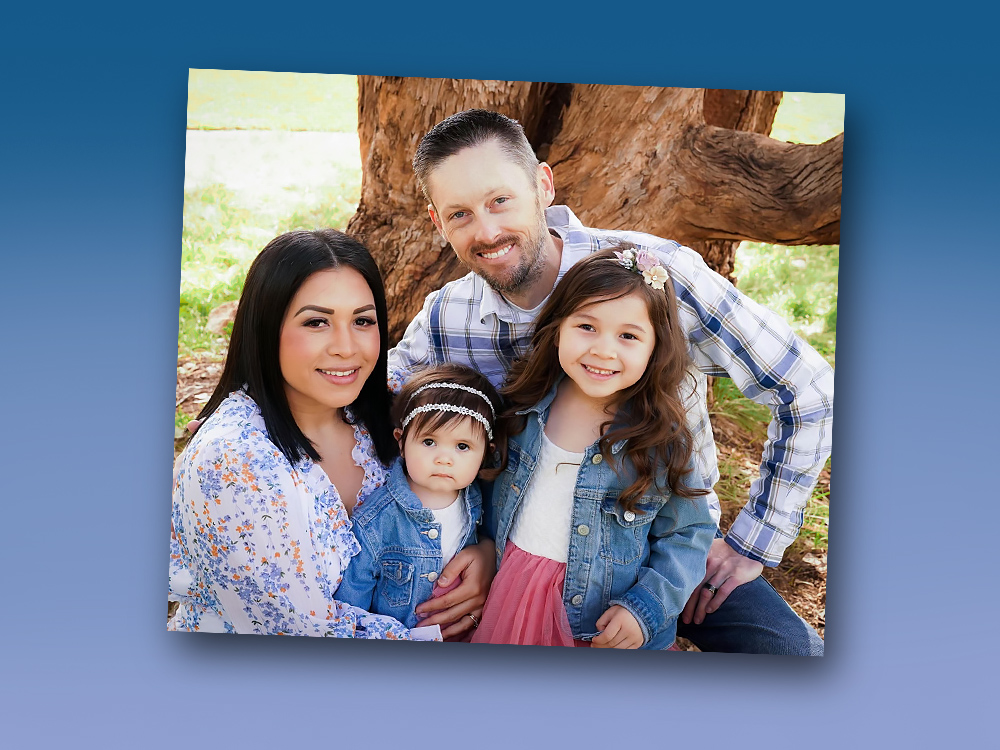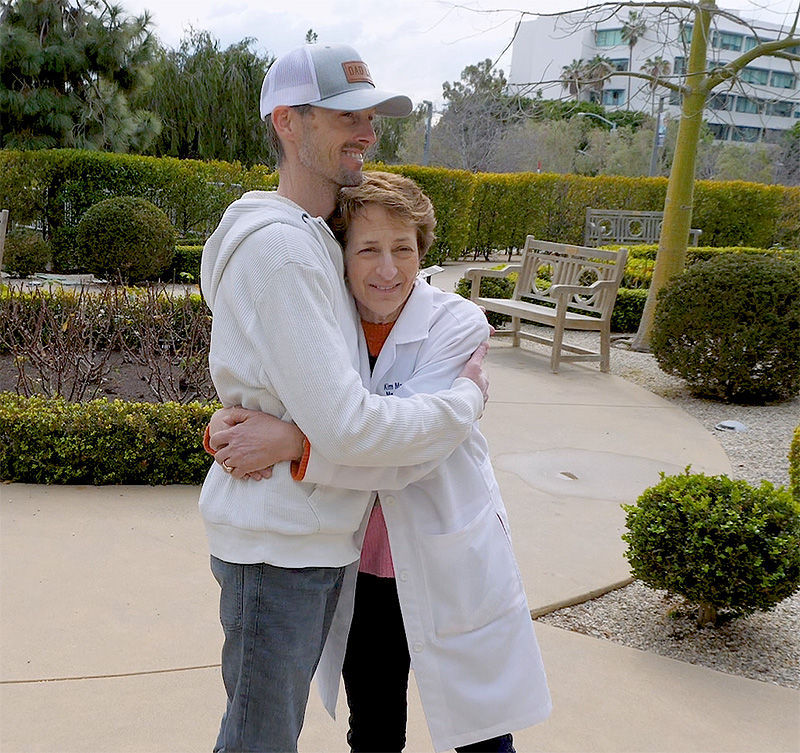
Retired Air Force Sergeant Survives a Rare and Aggressive Stage 4 Melanoma Diagnosis
In a span of two months, Michael Antonson, 35, started sweating uncontrollably, feeling an undue amount of fatigue, and running high fevers. He was rushed to the emergency room for what was initially considered pneumonia and was put on antibiotics. When the antibiotics didn’t resolve his symptoms, which were gradually getting worse, his doctors rushed other diagnostic tests to figure out what he had.
In his testimonial, Mike referred to his cancer as, “melanoma of the organs,” because his scans revealed multiple lesions, otherwise known as metastases, across his internal organs. These lesions were on his spleen, liver, both lungs and spine. The tumors were so aggressive that his anatomy was permanently altered. His right lung permanently smaller than his left, and his liver moved from the bottom of his stomach to the top of his chest. When looking at his scans with Dr. Margolin, “the volume of his right lung was at 10 percent of his left,” indicating that his left was compensating for the right, where the largest tumor was located.
Since melanomas are usually a malignancy of the skin, he was initially diagnosed with lung cancer, according to his medical oncologist, Dr. Kim Margolin Director of Medical Oncology of the Melanoma and Skin Cancer Program at Saint John’s Cancer Institute in Santa Monica, California.
A False Diagnosis: Stage 4 Lung Cancer
Due to Mike’s disease being apparent on the lungs, his doctors ultimately diagnosed him with metastatic lung cancer, and immediately starting him on chemotherapy and radiation, while at Riverside Hospital. The lesions on his lungs also aligned with how he got cancer; during two deployments to Afghanistan, Mike was in the sun and worked near the burn pits in Kandahar: breathing in toxins and not wearing any protective sunscreen. However, in a recent study published in February 2023 from the Pentagon, it revealed almost 900,000 service members in the Airforce between 1992 and 2017 had 87 percent higher rates of melanoma than non-Airforce personnel4.
Once they determined he had a subtype of melanoma, but couldn’t figure out where he had melanoma, they sent him to City of Hope, where Dr. Margolin practiced at the time.
Mike did not receive standard-of-care for his advanced melanoma. Standard of care dictates to physicians how to treat someone for a certain disease type. Mikes was an unfamiliar and rare subtype of melanoma, to which there is no standard of care for. Dr. Margolin performed what is known to as, “the art of medicine.” A method of problem-solving appropriate care for his condition in real-time so she may give him a chance to save his life.
“Dr. Margolin came into the picture and basically saved my life. She didn’t sugar coat anything. I’ll follow her wherever she goes,” says Mike. And he did, he followed her to Saint John’s Health Center and Institute, where he now drives two hours to see her.
Listen to Mike Retell His Remarkable Story of a Rare Melanoma and Meet Dr. Margolin
Mike Antonson, Dr. Margolin, and SJCI Staff talk in the Rose Gardens at Saint John’s Health Center.
A Melanoma BRAF Mutation
BRAF mutations can occur in multiple cancers, such as lung cancer. Which explains further why he was diagnosed with lung cancer initially. However, Mike’s mutated genes indicated he had a type of melanoma and not a lung cancer. His chemotherapy stopped immediately, and he was quickly put on targeted therapies instead to stop the growth. “A BRAF mutation is a spontaneous change in the BRAF gene that makes it work incorrectly. A mutation causes the gene to turn on the protein and keep it on, which means certain cells get ongoing signals to keep dividing and no instructions on when to stop. This can lead to development of a tumor,” according to John Hopkins University1.
BRAF mutations are not hereditary and develop for unknown reasons. You can get tested today to see if you have this mutation, regardless if cancer is present. This test will indicate if you could get cancer and would alert your physician to watch your health more closely.
Dr. Margolin is very focused and very determined. I found my trust in her quickly. The thing about her is, even if it’s something small, she wants to attack it and figure it out.
– Mike Antonson
Targeted Therapy and BRAF Inhibitors
“Targeted therapies, everyone responds well with,” says Dr. Margolin. However, targeted therapies are a quick fix because the cancer will grow back. BRAF inhibitors (a targeted therapy approach) stop the BRAF genes from growing, but only while on a targeted therapy, and for a certain time. The tricky thing is, they are not a durable form of cancer suppression.
In a multi-institution study that compared targeted therapy and immunotherapy, it found targeted therapies worked for everyone with BRAF mutant melanoma, but only while on the therapy. Once taken off, the cancer grows back, and after about one year the therapy becomes ineffective. In other words, it doesn’t stop recurrence. Immunotherapies, however, were found to be more durable. Once taken off, cancer recurrence remained low because patients’ bodies learned to fight the cancer versus relying on a medication to suppress cancer growth.2 The issue with immunotherapy is, it takes time for it to work, and the patient may not do well while waiting for an immune response to take effect.
Mike’s Disease and His Body’s Response
Mike was very sick and many people, including his care team, were not sure he would make it. He went from 177 pounds of muscle, being “a gym nut,” working out every day, to just 120 pounds in two months. He was fasting for the multiple bronchoscopies he had, while on antibiotics and drip IV for nourishment. For three weeks, he was in the ICU to which he said, “I don’t remember 90 percent of that. I do remember my wife crying because the doctors were telling her prep herself.” Mike was heavily sedated while in the ICU which is why he can’t remember.
“The doctors were not confident I was going to make it. So, they asked me to talk to my friends and family… I remember thinking in my head, Nah, I’m good. I’m going to fight this and beat this… I never thought I was going to die…”
Mikes response to his severe condition was always positive reassurances to himself, which in many cases is all one can do for oneself while relying on others. He had faith. Mike was on targeted therapies for 4 weeks before Dr. Margolin noticed his liver presented with an abnormality and switched him to a combination immunotherapy, OPDIVOTM, and YerovyTM—a known immunotherapy treatment approved for most advanced metastatic cancers.3 Dr. Margolin didn’t necessarily want to switch him to immunotherapy but, his liver was in no condition to take more targeted therapy treatments.
This is when one can perceive Dr. Margolin’s expertise and her ability to use the art of medicine to give Mike the chance he needed. Even though immunotherapy saved his life, it was targeted therapies that helped him regain strength for immunotherapy to work.
Immunotherapy for Advanced Melanomas
Dr. Margolin took a risk by taking Mike off targeted therapy and putting him on immunotherapy. A lot hinges on the biology of the tumor. “When melanomas respond to immunotherapy, it responds for a longer period of time,” says Dr. Margolin. Suggesting that immunotherapy treatments are more durable than targeted therapies, but they don’t always work.
Why not leave him on targeted therapy while waiting to see if the immunotherapy works? Targeted therapy and immunotherapy together are toxic to a person. Dr. Margolin was forced in another direction.
I had to retrain my whole body to sit up, stand, and then walk. It was weird to go from 2 hours in the gym to learning how to walk again.
– Mike Antonson
What gave Mike a chance for immunotherapy to work?
Mike stayed on immunotherapy for 2 years, a time period which is typical for advance diseases. He is considered in complete remission today. Typical of the kind of person Dr. Margolin is, she keeps a photo of Mike and his family on her desk that Mike sent her.
I went from essentially dying, and then to weeks later being discharged.
– Mike Antonson
A Veteran of the US Military
Mike was in the Air Force and retired to a Technical Sergeant, E-6, “even though I was eligible the last two years for E-7,” he remarked to me in an email and laughed, “ha-ha.” His sense of humor obviously not tarnished by his experiences. Though Mike can no longer be in the military due to his condition, that hasn’t stopped him from enjoying his life.

Mike Races Mustangs! (cars, not horses).
One thing different, he says, “You must be in shape,” to race cars. “Those NASCAR guys are out there for a long time, and it’s physically exhausting.” He said he now has new norms. “My heart rate is always in the 90’s or 100’s. That’s the new norm. I have new norms now. I must pace myself. After 40 minutes, I must stop.” For about eight years, Michael would compete nationally in a race called, Search for the Ultimate Street Car.
Advice from Mike to Others
- Don’t focus so much on the cancer. Focus on the future, focus on what motivates you, on the lifestyle you had before.
- A lot of people asked me what my motivation was, it was my faith.
- My wife, she was there every day in the hospital; she was amazing.
- Dr. Margolin gave me a lot of motivation.
- I’ve heard sad stories of people who aren’t positive, and they give up right when they’ve been diagnosed. I always wanted to tell people what another person who had cancer for 10 years told me, and that is to stay positive. Even if you have one day left. Do you want to spend that day sad, and depressed, or happy?
- I tried to fight through everything. It took me a lot to go to the hospital. Now, I would say, go get checked as soon as possible, and talk to your doctor about your concerns.
- Work Out. If my body wasn’t in the condition it was in, and healthy, my body wouldn’t have made it. If I wasn’t healthy, my body would have been too weak to fight all that was going on.
Sources
- BRAF Mutation and Cancer | Johns Hopkins Medicine
- Combination Dabrafenib and Trametinib Versus Combination Nivolumab and Ipilimumab for Patients With Advanced BRAF-Mutant Melanoma: The DREAMseq Trial-ECOG-ACRIN EA6134 – PubMed (nih.gov)
- Opdivo (nivolumab) FDA Approval History – Drugs.com
- Military Pilots-Cancer Study – DocumentCloud



